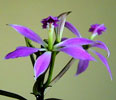|
|
|
|
|
| |
Flasks of
Epidendrum imatophyllum 'Jim' -spontaneous |
|
| |
|
|
| |
|
|
Click to Enlarge

Pod Parent Flowers |
|
|
|
| |
For additional origin/habitat information supplied courtesy of
Charles and Margaret Baker, see further below, near the bottom of this page.
|
Temperatures we attempt to use in the lab & greenhouse:
| For Species: |
|
Spring, Summer, Autumn, Winter: days average 89°F, nights 70°F; best fit is Warm 90-70°F
(Source:
Baker's Web OSC) |
|
About the name...
| Etymology of |
Epidendrum |
|
From Greek "epi" upon; "dendron" tree.
(Source:
Pridgeon 1992) |
| Etymology of |
imatophyllum |
|
From latinized Greek "imatophyllus" with whip-like, strap-like leaves.
(Source:
Mayr & Schmucker 1998) |
| Pronunciation of |
Epidendrum |
|
eh-pee-DEN-drum
(Source:
Pridgeon 1992) |
| Pronunciation of |
imatophyllum |
|
i-mah-toe-FIL-um
(Source:
Hawkes 1978) |
|
If you would like to direct someone to this web page, please copy and paste this URL into your email:
http://troymeyers.com/d?012068
| Flask Information |
| Availability: |
We had yield problems with this item, so we didn't continue flasking it. |
| You should: |
Consider placing a "Notify Retries" Request, and if an identical pollination (the same parents) is done again, we'll let you know. |
|
You might also want to:
|
View the seed assay for this item.
View items of the same species.
View items of the same genus.
|
|
|
| |
The origin/habitat information below is supplied courtesy of Charles and Margaret Baker
The following information is based on the name of the plant provided by the donor, and assumes that the name is correct. If the plant has been misidentified, then the following information may not be correct.
This text is copyrighted by the Bakers and may not be reproduced without permission.
ORIGIN/HABITAT: Distributed from Mexico southward through Central America
to Venezuela, the Guianas, Brazil, and Peru in South America. In Mexico,
plants have been found in the states of Vera Cruz, Oaxaca, Tabasco,
Yucatan, and Quintana Roo. In Guatemala, plants have been collected from
numerous locations in the departments of Alta Verapaz, Izabal, and Petén
where they grow on trees, often on ant nests, in dense, often swamp,
forests at up to 3300 ft. (1000 m). Plants have been reported in Nicaragua
where they were growing along the Río Coco in north-central Nicaragua at
about 450 ft. (140 m) near the border with Honduras. In Coast Rica, plants
are reported from both the Caribbean and Pacific lowlands. Plants in
Panama have been found in the Canal Zone in Mojinga swamp and at several
locations in Panamá Province. Williams & Allen (1980) reported, "This
species usually has its roots inhabited by ants. It is said to deteriorate
in cultivation if the ants are exterminated." In Venezuela, plants have
been found growing as terrestrials or epiphytes the states of Anzoategui,
Bolívar, Miranda, Zulia, and in the Federal Territories of Amazonas and
Delta Amacuro at 350-1950 ft. (100-600 m). In Peru, plants have been found
near Iquitos in the department of Loreto where they were growing
epiphytically in low-elevation, moist, tropical forest.
More about this information and the Bakers...
|
|
|
| |
|
|
|